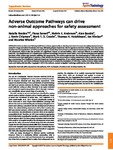Adverse Outcome Pathways can drive non-animal approaches for safety assessment.
| dc.contributor.author | Burden, N | en |
| dc.contributor.author | Sewell, F | en |
| dc.contributor.author | Andersen, ME | en |
| dc.contributor.author | Boobis, A | en |
| dc.contributor.author | Chipman, JK | en |
| dc.contributor.author | Cronin, MTD | en |
| dc.contributor.author | Hutchinson, TH | en |
| dc.contributor.author | Kimber, I | en |
| dc.contributor.author | Whelan, M | en |
| dc.date.accessioned | 2017-05-17T08:50:08Z | |
| dc.date.available | 2017-05-17T08:50:08Z | |
| dc.date.issued | 2015-09 | en |
| dc.identifier.uri | http://hdl.handle.net/10026.1/9266 | |
| dc.description.abstract |
Adverse Outcome Pathways (AOPs) provide an opportunity to develop new and more accurate safety assessment processes for drugs and other chemicals, and may ultimately play an important role in regulatory decision making. Not only can the development and application of AOPs pave the way for the development of improved evidence-based approaches for hazard and risk assessment, there is also the promise of a significant impact on animal welfare, with a reduced reliance on animal-based methods. The establishment of a useable and coherent knowledge framework under which AOPs will be developed and applied has been a first critical step towards realizing this opportunity. This article explores how the development of AOPs under this framework, and their application in practice, could benefit the science and practice of safety assessment, while in parallel stimulating a move away from traditional methods towards an increased acceptance of non-animal approaches. We discuss here the key areas where current, and future initiatives should be focused to enable the translation of AOPs into routine chemical safety assessment, and lasting 3Rs benefits. | en |
| dc.format.extent | 971 - 975 | en |
| dc.language | eng | en |
| dc.language.iso | eng | en |
| dc.subject | 3Rs | en |
| dc.subject | AOP | en |
| dc.subject | chemical | en |
| dc.subject | mechanism of action | en |
| dc.subject | mode of action | en |
| dc.subject | pathway | en |
| dc.subject | risk | en |
| dc.subject | safety assessment | en |
| dc.subject | toxicity | en |
| dc.subject | Animal Testing Alternatives | en |
| dc.subject | Computer Simulation | en |
| dc.subject | Decision Making | en |
| dc.subject | Models, Biological | en |
| dc.subject | Risk Assessment | en |
| dc.subject | Toxicity Tests | en |
| dc.title | Adverse Outcome Pathways can drive non-animal approaches for safety assessment. | en |
| dc.type | Journal Article | |
| plymouth.author-url | https://www.ncbi.nlm.nih.gov/pubmed/25943792 | en |
| plymouth.issue | 9 | en |
| plymouth.volume | 35 | en |
| plymouth.publication-status | Published | en |
| plymouth.journal | J Appl Toxicol | en |
| dc.identifier.doi | 10.1002/jat.3165 | en |
| plymouth.organisational-group | /Plymouth | |
| plymouth.organisational-group | /Plymouth/Research Groups | |
| plymouth.organisational-group | /Plymouth/Research Groups/BEACh | |
| plymouth.organisational-group | /Plymouth/Users by role | |
| dc.publisher.place | England | en |
| dcterms.dateAccepted | 2015-03-19 | en |
| dc.identifier.eissn | 1099-1263 | en |
| dc.rights.embargoperiod | Not known | en |
| rioxxterms.versionofrecord | 10.1002/jat.3165 | en |
| rioxxterms.licenseref.uri | http://www.rioxx.net/licenses/all-rights-reserved | en |
| rioxxterms.licenseref.startdate | 2015-09 | en |
| rioxxterms.type | Journal Article/Review | en |


